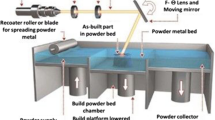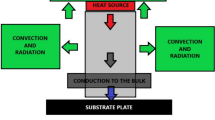Abstract
Ultrasonic shot peen forming (USPF) is a promising and widely used forming technique for thin metallic parts. In this paper, detailed deformation behavior of the aluminum alloy ring caused by USPF was studied, which is of a great significance to industrial applications for roundness correction and reshaping of the ring parts, such as wheel hub, petrochemical containers, pressure vessels, and spacecraft shells. Firstly, the motion of the single pin during USPF was recorded by a high-speed camera. Then, by combining the recorded results and the stress wave theory, the firing pin motion was approximately described as an effective impact of 100 times per second and the average impact velocity of 5 m/s. By considering the firing pin movement, the 3D USPF FE model of a cell AA6061-T6 sheet was developed successfully for obtaining the accurate plastic strain field. Subsequently, a 2D USPF FE model of the ring part was developed, which is able to obtain similar residual stress profiles with the 3D cell’s FE model by inputting the plastic strain profiles induced by the firing pin impact. Based on the results of experimental and numerical simulation, it was observed that the convex deformation of the ring part increases as the wall thickness decreases and the central angle of the treatment area increases. In addition, a wave contour and a local deformation with a little influence on the other area of the ring part can be achieved by three USPF treatment areas distributed in one-sided surface and two-sided surface, respectively.

















Similar content being viewed by others
Availability of data and materials
The data and materials used or analyzed during the current study are available from the corresponding author on reasonable request.
References
Xing Y, Lu J (2004) An experimental study of residual stress induced by ultrasonic shot peening. J Mater Process Technol 152(1):56–61
Wu J, Liu H, Wei P, Zhu C (2020) Lin Q (2020) Effect of shot peening coverage on hardness, residual stress and surface morphology of carburized rollers. Surf Coat Technol 384:125273
Miao H, Demers D, Larose S, Perron C, Martin L (2010) Experimental study of shot peening and stress peen forming. J Mater Process Technol 210(15):2089–2102
Gariépy A, Larose S, Perron C, Bocher P, Lévesque M (2013) On the effect of the orientation of sheet rolling direction in shot peen forming. J Mater Process Technol 213(6):926–938
Gariépy A, Larose S, Perron C, Bocher P, Lévesque M (2013) On the effect of the peening trajectory in shot peen forming. Finite Elem Anal Des 69:48–61
Zhang T, Li L, Lu S, Gong H (2019) Simulation of prestressed ultrasonic peen forming on bending deformation and residual stress distribution. International Journal of Advanced Manufacturing Technology China 29:270–278
Xiao X, Wang Y, Zhang W, Wang J, Wei S (2014) Numerical simulation of stress peen forming with regular indentation. Procedia Eng 81:867–872
Xiao X, Tong X, Liu Y, Zhao R, Gao G, Li Y (2018) Prediction of shot peen forming effects with single and repeated impacts. Int J Mech Sci 137:182–194
Hu Y, Grandhi RV (2012) Efficient numerical prediction of residual stress and deformation for large-scale laser shock processing using the eigenstrain methodology. Surf Coat Technol 206(15):3374–3385
Hu Y, Li Z, Yu X, Yao Z (2015) Effect of elastic prestress on the laser peen forming of aluminum alloy 2024-t351: experiments and eigenstrain-based modeling. J Mater Process Technol 221:214–224
Guo C, Hu S, Wang D, Wang Z (2015) Finite element analysis of the effect of the controlled parameters on plate forming induced by ultrasonic impact forming process. Appl Surf Sci 353:382–390
Wu B, Zhang L, Zhang J, Murakami R, Pyoun Y (2015) An investigation of ultrasonic nanocrystal surface modification machining process by numerical simulation. Adv Eng Softw 83:59–69
Park H, Kim J, Pyun Y, Auezhan A, Choi YS (2019) Numerical and experimental studies on subscale behaviors of ultrasonic surface peening. Met Mater Int 25(3):606–616
Srikanth T, Surendran S, Balaganesan G, Manjunath GL (2017) Response of CMT welded aluminum AA5086-H111 to AA6061-T6 plate with AA4043 filler for ballistic. Procedia Eng 194:522–528
Boldyrev IS, Shchurov IA, Nikonov AV (2016) Numerical simulation of the aluminum 6061-T6 cutting and the effect of the constitutive material model and failure criteria on cutting forces’ prediction. Procedia Eng 150:866–870
Zhang XJ, Wang T, Wang JB, Liu C (2017) Analytical modeling of shot peen forming process using cross-sectional linear indentation coverage method. Int J Mech Sci 133:838–845
Funding
This research work was financially supported by the Ningbo Science and Technology lnnovation 2025 Major Special Project (2018B10059), Ningbo 3315 Innovation Team—Ultrasonic Impact Treatment Technology and Equipment (Y80929DL04), and the Natural Science Foundation of Ningbo (202003N4356, 2019A610166, 2019A610163).
Author information
Authors and Affiliations
Contributions
Qinglong Zhang wrote the manuscript.
Qinglong Zhang and Su Zhao contributed to the concepts and design of the study.
Qinglong Zhang and Menggang Zhai developed the devices and completed experimental research.
Hao Li contributed to the FE simulation work and data analysis.
Aziz Ul Hassan Mohsan and Su Zhao reviewed and edited the manuscript.
Corresponding author
Ethics declarations
Ethical approval
Not applicable.
Consent to participate
Not applicable.
Consent to publish
The authors agree to publish this paper in International Journal of Advanced Manufacturing Technology.
Competing interests
The authors declare no competing interests.
Additional information
Publisher’s note
Springer Nature remains neutral with regard to jurisdictional claims in published maps and institutional affiliations.
Rights and permissions
About this article
Cite this article
Zhang, Q., Li, H., Zhai, M. et al. Numerical and experimental study on the deformation of aluminum alloy ring treated by ultrasonic shot peen forming. Int J Adv Manuf Technol 113, 2791–2804 (2021). https://doi.org/10.1007/s00170-021-06786-0
Received:
Accepted:
Published:
Issue Date:
DOI: https://doi.org/10.1007/s00170-021-06786-0




